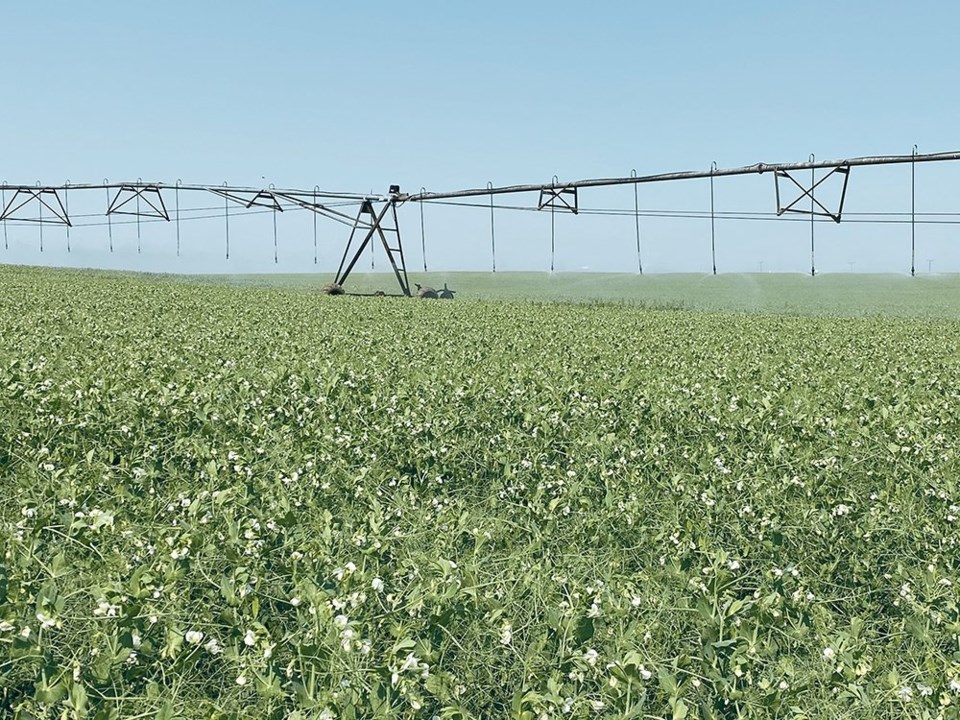WESTERN PRODUCER — The Canada Infrastructure Bank is ready to discuss investing in Saskatchewan’s $4-billion irrigation project if the provincial government asks.
The bank has already spent almost half-a-billion dollars in Alberta’s irrigation sector. It’s also working on a project to alleviate congestion at the port of Vancouver.
Director Pat Youzwa, a former president of SaskPower, said investing in agricultural infrastructure is part of the bank’s mandate.
Speaking at Canada’s Farm Show, she said the first agricultural investment was an irrigation modernization and expansion project in partnership with the Alberta government.
“We anticipate an expansion in the number of acres that will have access to irrigation, up to 208,000,” she said. “We’ll also improve the management of water, which I think will be increasingly important as we start looking at the impacts of climate change.”
The project is also expected to boost Alberta’s gross domestic product by about $500 million each year, she said.
Youzwa said the bank is aware of Saskatchewan’s planned project.
“We’re willing and happy to engage with the government of Saskatchewan when they are ready to do so to see if there might be an opportunity for us to also play a role in this very important project,” she said.
Jodie Parmar, the bank’s senior director of project development in Western Canada, said he spoke with the Saskatchewan government shortly after its July 2, 2020, announcement.
“I was here approximately a week later. I did spend time with deputy premier (Gordon) Wyant, at that time, who was responsible for SaskBuilds, and a number of other ministers and officials,” he said. “We spent an entire day up at Lake Diefenbaker. We did a tour of the Westside (irrigation project).”
Parmar said the CIB is waiting for the government to complete its technical and financial work and to reach out.
The Saskatchewan government has said in the past it wasn’t that happy about being directed toward the CIB, and a loan, rather than direct federal investment in the project.
Parmar said the bank’s involvement would not be through a grant or a forgivable loan.
“The bank makes either senior loans, subordinated loans, we even could do preferred equity,” he said. “We’ll assess the project.”
Parmar also said the bank can work quickly when asked to be involved.
For example, in Alberta, he and his team began working on that investment in August 2020 and the financial closing took place in December.
“We’re here to deliver quickly investments in critical infrastructure and definitely we believe that the Saskatchewan irrigation project is one of those critical, key, once-in-a-generation, transformational projects that would make a fundamental change to the province and the bank is there to invest in it.”
The federal government allocated $35 billion to the bank, which will be spent over 10 years in five priority areas: public transit, clean power, green infrastructure, broadband and trade and transportation. Agricultural investment falls into the last category.
She said the bank partners with the private sector and other governments.
There is $5 billion available for leveraging work in trade and transportation.
Youzwa said the CIB has built momentum.
“To date we have invested in projects for a total value of over $21 billion. The bank itself has made financial commitments of $7.6 billion and our commitment has been matched by private sector investment of $7.7 billion. We’ve also partnered with public sector partners who have contributed $6 billion to these projects.”
One of the other agriculturally related projects involves the New Westminster Bridge in British Columbia’s Lower Mainland.
Youzwa said the bank is looking at the entire Asia-Pacific Gateway transportation network throughout Western Canada.
The bridge was built in 1904, is owned by the federal government and operated by Canadian National Railway.
“It is experiencing congestion problems and is expected to reach capacity in the next few years,” said Youzwa. “We are using our accelerator fund — we have a set-aside of money to be able to accelerate development of projects. We’re going to use that to study what the options might be to rehabilitate, replace and maintain the bridge for the future.”
The bank is also looking at other areas, including the growing demand for plant-based protein and biofuels. It can look at processing facilities, Youzwa said.
“The Canada Infrastructure Bank is looking to focus its efforts on large, transformational projects,” she said, with a minimum investment of $100 million and a minimum capital expenditure of $200 million.
Cherilyn Jolly-Nagel, a Mossbank, Sask., farmer who emceed the event, said she was worried by a recent Canada West Foundation transportation paper that said Canada had dropped from the top 10 of most reliable trading countries.
“This year, we have come up at number 32,” she said. “That’s kind of a dismal rating.”
She said agriculture is well-positioned for growth.
“But I do worry that we are a decade behind in the infrastructure that is needed to truly capitalize on those opportunities. Can we catch up?”

